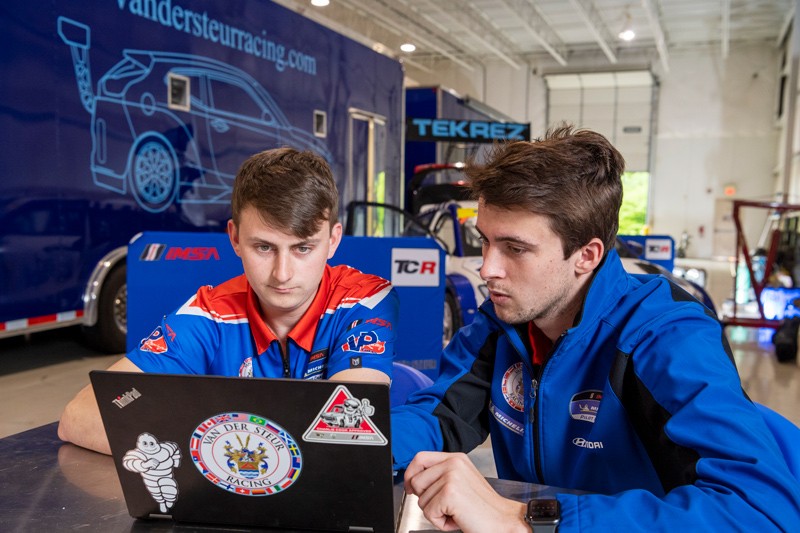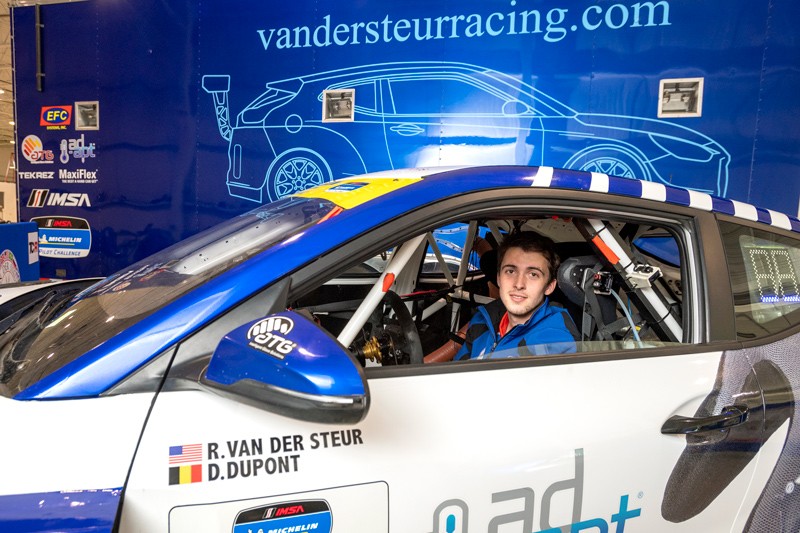Mechanical engineering student Rory van der Steur spent junior year as rookie race car driver
The automobile is a feat of engineering, and for Rory van der Steur, a junior studying mechanical engineering at the University of Delaware, his interests in engineering and car racing fit together perfectly.
His father was a professional racer, so he grew up with the sport. “I’ve always been fascinated by cars,” said van der Steur. “I have a picture of me at three years old holding a model race car.”
Then, when he was four, his dad bought him a go-kart. “Go-kart racing is really the stepping stone for car racing,” said van der Steur. “You have to learn all the fundamentals before you go into a car.”
He raced go-karts for 13 years before making the leap to car racing this season. He races in the International Motor Sports Association (IMSA) Michelin Pilot Challenge series, driving a Hyundai Veloster N TCR.
Races range from two to four hours, and van der Steur alternates with another driver. Careful pit stops and tire changes are critical to their success. These are very strategic endurance races. The team has an engineer, crew chief and strategist who constantly monitor fuel economy and other metrics of the car’s function as well as the car’s position among competitors. They change tires and other components mid-race to optimize the car. “It’s not always about the fastest driver because anything can happen,” he said. “It’s all about strategy.”
The team started working together in October 2020. Aerodynamics is really important for maximizing speed on the track. The team constantly modifies the car at their headquarters in Havre De Grace, Maryland, and van der Steur can feel even slight changes in the car’s hardware. After all, he’s going around corners at 135 miles per hour. “It’s very scary at times,” he says. Top speed is 165 to 170 mph.
Fortunately, van der Steur built a strong foundation in engineering principles, which are critical to understanding cars, during his years as a UD engineering student.
“Almost every engineering class will go back into what the fundamentals of a racecar are, just like the normal statics problem with torque or moments; it’s very broad, but there are so many moving parts in a racecar,” van der Steur said. The car is also equipped with a lot of electronics, and van der Steur’s engineering background helps him navigate these tiny computers and sensors.
Another engineer working on this effort is crew chief Chris Deely, a UD alumnus who was president of the Formula Society of Automotive Engineers (FSAE) during his time as a student. This team works to design and build a racecar, and the team improved its place in the standings during Deely’s time at the helm. He graduated with a bachelor’s degree in mechanical engineering in 2019. Courses in powertrain theory and motorsports informed his path. He even visited Daytona in 2017 during the Winter Session course on Engineering Motorsports. Later, he was a part of that same race. “That class was what I do now every day,” he said.

College of Engineering student Rory van der Steur (right) has been able to juggle his mechanical engineering studies and his passion for race car driving, something he has done since the age of four. Rory’s crew chief, Chris Deely, is also a UD alum.
A mutual Blue Hen friend and alumnus connected Deely with van der Steur. Deely’s job is to make sure the car is ready for each race.
“After each race, we pull apart probably 50% of the car and check everything, make sure every nut and bolt is tight, make sure every component is free of cracks and in good condition because our races are two to four hours and we put in so much work, just hours on hours, to make sure that the car survives for those two to four hours,” said Deely.
During the 2020-2021 academic year, van der Steur took care to finish his assignments before races and even attend online lectures in between practice runs at the track. For example, he completed a solids lab right from an RV before a big race in March.
That race didn’t go quite as planned — a crash kept van der Steur from finishing. But he continues to practice for the next race and is optimistic about his future career in racing.
| Photos by Kathy F. Atkinson | July 12, 2021


